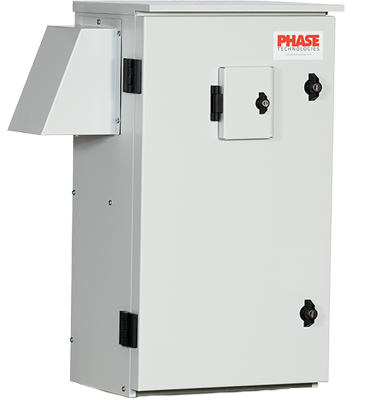
Output Voltage Explained
The output voltage for a 2XD Series Drive is generally less than 480V. Voltage drops occur through output filters, input filters, and line losses; these are common phenomenon and should not be a cause for concern under most circumstances. For Phase Technologies voltage doubling 2XD Series VFD Drives equipped with an output filter, the estimated actual output voltage (for a given input voltage and output current) is shown in the table below.
| 2XD Series VFD Estimated Output Voltage | ||||
| Model | 2XD205R-OF | 2XD207R-OF | 2XD210R-OF | 2XD215R-OFD |
| Input Voltage V | 240 | 240 | 240 | 240 |
| Output Current A | 10 | 13 | 18 | 24 |
| Input Inductor Impedance % | 3.07 | 3.8 | 4 | 4.1 |
| Output Filter Impedance* % | 2.8 | 3.7 | 5.4 | 1.5 |
| Total Impedance % | 5.87 | 7.5 | 9.4 | 5.6 |
| Output Voltage V | 451 | 444 | 434 | 453 |
| * The 2XD205R-OF, 2XD207R-OF, and 2XD210R-OF use a sinewave output filter, while the 2XD215R-OFD has a dv/dt output filter. | ||||
NEMA Motor Voltage Tolerances
Though utility power is commonly stated to be 480V nominal, motors are generally designed for a nominal voltage of 460V. Additionally, NEMA motors are designed to tolerate voltage swings of ±10%. Thus, on a typical 460V motor this would equate to an operating range of 414V at the lower limit and 506V at the upper limit. The typical output voltages of a 2XD Series VFD comfortably fit within the 10% range of a NEMA 460V motor.
Effects of High and Low Voltage on an Induction Motor
A common misconception is that because low voltage increases current on a motor, high voltage must be an improvement or will decrease current draw and reduce heat on said motor. This is not reality. High voltage on a motor will cause the magnetic in the motor to saturate. This effect, in turn, causes the motor to draw more current in an effort to magnetize the iron beyond the point where magnetizing is practical. In reality, the ideal voltage to supply a motor is the rated voltage for the motor.
Summary
When supplied with 240V input, 2XD Series VFDs may exhibit output voltages less than 480V due to voltage losses within the drive. However, the power provided by these drives will still comfortably meet the ± 10% voltage requirements for a standard NEMA 460V motor. Additionally, the commonly held “bigger is better” belief that higher voltage is better for a motor is not accurate – high voltage to a motor also causes additional current draw, though for different reasons than low voltage conditions.